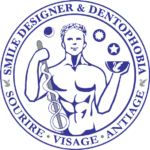OUR SOLUTION N°6 : THE ZYGOMATIC
ZYGOMATIC IMPLANTS WHEN
THE JAWBONE IS TOTALLY ATROPHIED
The solution of zygomatic implants for totally edentulous people with a completely resorbed alveolar bone arch
THE SMILE DESIGNER SOLUTION N°6: ZYGOMATIC IMPLANTS
AN IMPLANT ANCHOR ON THE BONE BASE OF THE CHEEKBONE
THE PLACEMENT OF A COMPLETE DENTAL PROSTHESIS IN IMMEDIATE LOADING
IN CASES OF EXTREME RESORPTION OF THE UPPER JAW
It was in Sweden, in the 90’s, that Professor Per Ingvar Brånemark invented the zygomatic implants in order to determine the best alternative to conventional dental implants.
Zygomatic implants are inserted into the alveolar bone of the jawbone. This consists of using the bone that forms the cheekbones (called the malar bone or zygomatic bone) as an anchor for the placement of dental implants called zygomatic.
This bone is a cortico-cancellous bone with good mechanical strength. Most patients have enough bone volume available for one or two or even three zygomatic implants.
When these zygomatic implants are connected to a screw-retained implant-supported bridge, they resist the forces of mastication in normal use.
Zygomatic implants are much longer than conventional dental implants since they are inserted in the foot of the malar, located above the upper jaw, where dental implants are usually placed.
PREVENTION OF CONTINGENCIES IN ORAL HEALING
What is the problem?
If bone loss over a long period of time is almost complete as a result of previous tooth extractions, conventional dental implants can no longer be placed because there is no longer sufficient peripheral bone volume.
What is the solution?
The solution consists of reconstructing the alveolar bone arch in order to give it back a sufficient volume that can be implanted.
This will usually require numerous large-scale bone grafts and in particular two sinus fillings.
What are the advantages of this solution?
- The patient avoids all bone grafts and two sinus fillings.
- Fixed total denture reconstructs the entire jawbone with a beautiful smile
- It is fixed on zygomatic implants in immediate loading.
What are the disadvantages of this solution?
This choice of protocol necessarily requires several complex bone grafting surgeries to reconstruct the entire alveolar perimeter of the maxilla.
Two large sinus fillings are required. In addition, there are usually ROG-type volume-increasing apposition grafts in the vertical and horizontal directions.
Assuming this round of reconstruction can be done, it takes a lot of time, energy and budget.
However, patients who have reached this stage are generally quite old and not very inclined to this type of protocol, which is quite heavy in terms of personal investment.
What are the alternatives?
- The first solution consists in navigating in the less atrophied areas to try to put implants and stabilize a removable prosthesis (denture) most often fixed with attachments that look like ” snaps “.
- The second solution consists of placing zygomatic implants in the upper jaw which is not affected by bone resorption. This solution is a complex surgical procedure. It is intended for patients who want a true reconstruction of their jaw and smile with a fixed total dental prosthesis. which reconstructs the jawbone with a beautiful smile is fixed on zygomatic implants in immediate loading.
WHO SHOULD HAVE ZYGOMATIC IMPLANTS?
They are indicated for totally edentulous patients with high bone resorption in the maxilla (upper jaws) when a fixed prosthesis is requested.
Zygomatic implants can only be used in the upper jaw since there are no bony structures, similar to the zygomatic bone, adjacent to the mandible (lower jaws).
In the case of severe atrophy of the alveolar bone of the lower jaw, the patient must be offered an alternative treatment plan to restore the mandibular dentition.
Zygomatic implants are also considered when patients can no longer tolerate removable prostheses (dentures) and when they no longer have enough bone tissue to consider conventional dental implants, without bone grafts, either for apposition or sinus filling.
WHAT ARE THE ADVANTAGES OF ZYGOMATIC IMPLANTS?
- Zygomatic implants avoid the need for bone grafts when there is not enough alveolar bone (the jawbone where the teeth are located) to insert conventional dental implants.
- They have an excellent survival rate. One study shows an average survival rate of the zygomatic implant of 95.12% at 10 years.
- The possible complications are less in the maxillary sinuses, as in the case of sinus filling (or sinus lift) for the placement of conventional implants, although the risk still exists, of course.
- Zygomatic implant placement planning is possible with, among other things, NobelClinician software. The insertion of zygomatic implants can therefore be computer-assisted. This allows the surgeon to simulate the procedure beforehand and to plan it. The results are therefore predictable, to a certain extent. This allows for optimal diagnosis, treatment plan and communication with the patient.
- The zygomatic implants allow you to leave with a temporary prosthesis screwed in immediately after surgery. It is the immediate loading. The multi-cortical anchorage in the zygomatic (or malar) bone allows for a high level of primary stability, making it possible to install an implant-supported prosthesis immediately after surgery, which restores masticatory function and smile aesthetics to the patient.
- The healing time is rather shorter than with conventional dental implants, thus optimizing the overall treatment time.
- The time of treatment is therefore very fast: After only one surgical intervention, the patient can have a fixed prosthesis the day the zygomatic implants are placed.
WHAT ARE THE DISADVANTAGES OF ZYGOMATIC IMPLANTS?
- Due to the small number of zygomatic implants placed and the absence of bone grafts, the implant-supported prosthesis fixed on the zygomatic implants must sometimes have a part that rests on the palate of the patient. The comfort and quality of the patient’s speech is thus somewhat diminished.
- Between one and three pairs of zygomatic implants (i.e. between 2 and 6 implants only) can be placed.
- If a problem occurs on one of the zygomatic implants, the whole implant-supported prosthesis will be unbalanced and may be doomed in the long run. Another solution will have to be found. Provided that this is possible and that the case is not definitively lost. 95% success rate means 5% failure rate.
- The protocol for placing zygomatic implants is very complex and difficult to perform. It is a true maxillofacial reconstruction surgery which, in my opinion, is only justified in extreme cases of rescue. The always possible failure does not allow an easy “backtracking”.
DESCRIPTION OF THE ZYGOMATIC IMPLANT PLACEMENT PROTOCOL
The preliminary study by a Cone Beam scanner allows the analysis of the bone structures, and specifically the cheekbone, in three dimensions.
The zygomatic implants are placed under deep sedation, such as general anesthesia, in the operating room.
There are two different ways of placing zygomatic implants depending on the degree of resorption of the anterior part of the jaw:
If the anterior part of the maxilla is not completely resorbed:
Zygomatic implants are usually placed in a single pair, combined with conventional implants in the anterior areas to ensure stability.
Usually 2 to 4 conventional implants are required in the anterior part.
In the posterior parts of the upper jaw, due to the extension (pneumatization) of the sinuses and the resorption of the alveolar ridge (where the teeth are normally located), there is often not enough residual bone volume to stabilize conventional dental implants.
In this situation, two zygomatic implants are placed in the region of the second premolar.
The cranial part of the zygomatic implants must be located in the cheekbone.
The dental part of the zygomatic implants must be placed on the alveolar bone crest, below the future premolars.
Zygomatic implants can be located inside, outside or in the bone wall of the external part of the maxillary sinus. The placement of the implant is determined exclusively by the two ends of the implant.
If the zygomatic implant is placed inside the jawbone, a Caldwell-Luc type window must be made, of varying size depending on the implant path.
2 to 4 conventional dental implants are placed at the same time, to stabilize the whole, at the height of the incisors and canines in the residual alveolar bone, below the nose.
The operation is always followed by immediate loading:
The patient will be able to have his or her fixed implant-supported dental prosthesis screwed onto all the implants, made of resin on a metal frame, within a week. A final version of this prosthesis with a ceramic rather than resin cosmetic will be placed 6 to 8 months later, if needed.
If the anterior part of the maxilla is totally atrophic
In this case, bone resorption is extreme. The implantable bone volume is insufficient, not only for the posterior part at the sinus level, but also for the anterior part where conventional dental implants can be placed.
2 to 3 pairs of zygomatic implants (4 to 6 implants on the left and on the right) can be placed in the zygomatic bone in this case.
In this case, no conventional dental implant is required as an anterior fixation relay.
In this case, bone resorption is extreme. The implantable bone volume is insufficient, not only for the posterior part at the sinus level, but also for the anterior part where conventional dental implants can be placed.
However, whenever possible, it is always recommended to place at least one additional conventional dental implant in the anterior region to achieve better stability.



